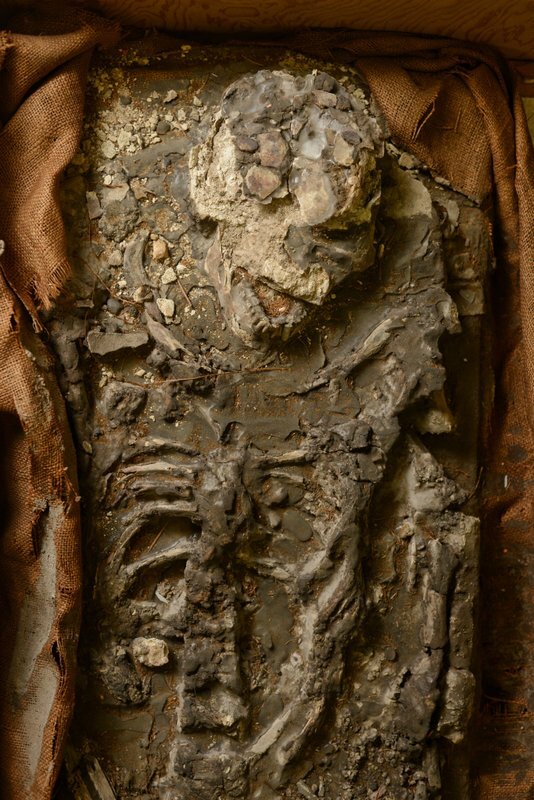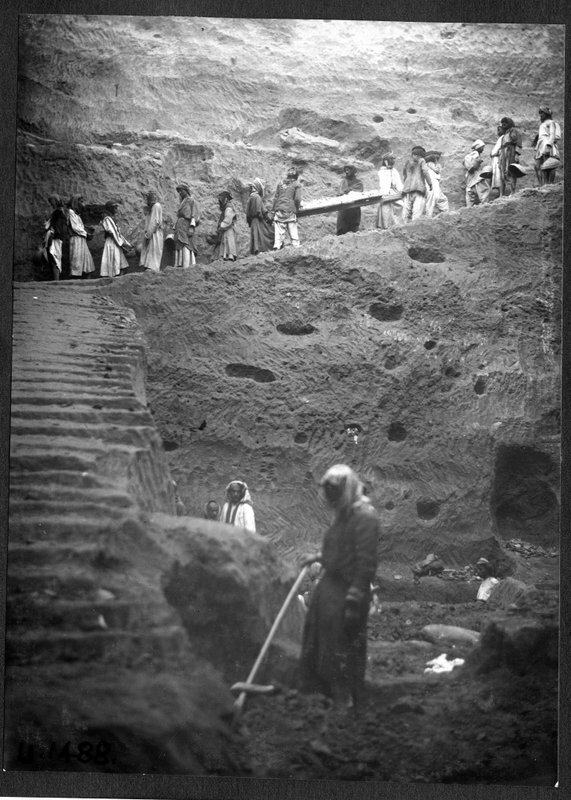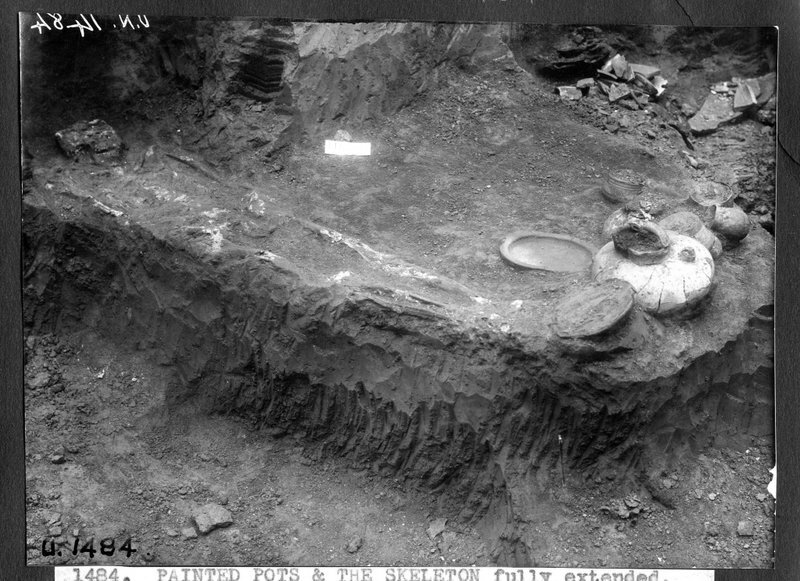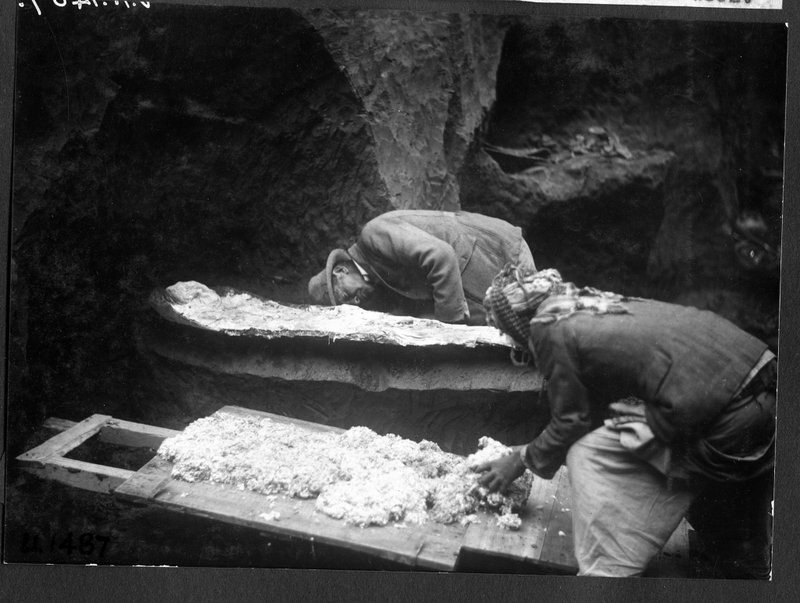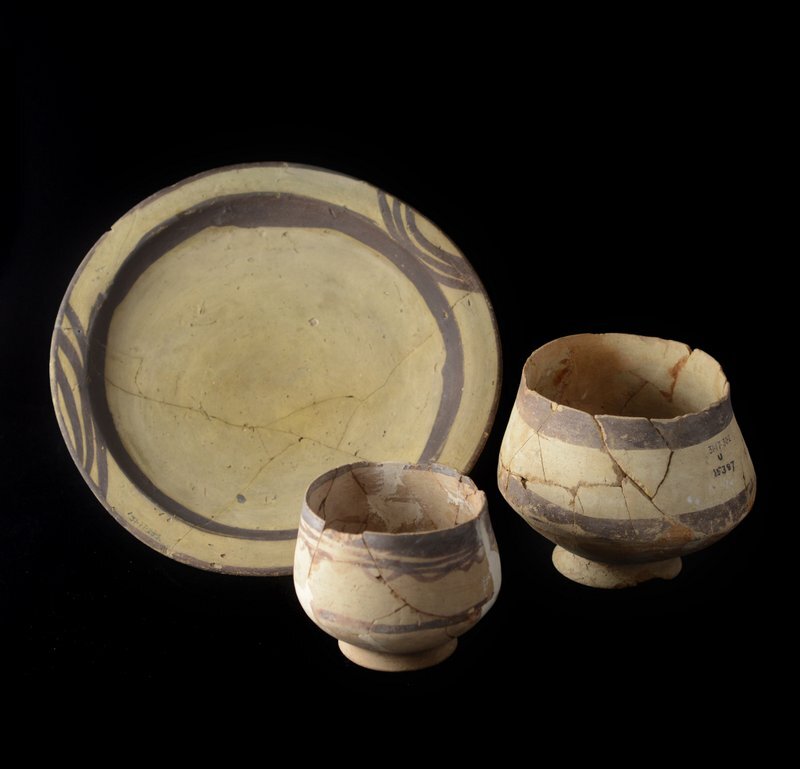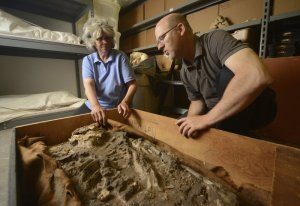
Philadelphia, PA Summer 2014— Sometimes the best archaeological discoveries aren’t made in the field. Scientists at the Penn Museum in Philadelphia have re-discovered an important find in their own storage rooms, a complete human skeleton about 6,500 years old. The mystery skeleton had been stored in a coffin-like box for 85 years, all trace of its identifying documentation gone. This summer, a project to digitize old records from a world-famous excavation brought that documentation, and the history of the skeleton, back to light.
Unearthed in 1929–30 by Sir Leonard Woolley’s joint Penn Museum/British Museum excavation team at the site of Ur in what is now southern Iraq, the skeleton is about 2,000 years older than the materials and remains found in the famous Mesopotamian “royal tombs,” the focus of a Penn Museum signature exhibition, Iraq’s Ancient Past: Rediscovering Ur’s Royal Cemetery. According to Dr. Janet Monge, Curator-in-Charge, Physical Anthropology Section of the Penn Museum, a visual examination of the skeleton indicates it is that of a once well-muscled male, about age 50 or older. Buried fully extended with arms at his sides and hands over his abdomen, he would have stood 5’ 8” to 5’ 10” tall.
Skeletons from this time in the ancient Near East, known as the Ubaid period (roughly 5500–4000 BCE) are extremely rare; complete skeletons from this period are even rarer. Woolley’s team excavated 48 graves in an early, Ubaid-era flood plain, nearly 50 feet below the surface of the site; of those, Woolley determined that only one skeleton was in condition to recover: the skeleton that has now been identified in the Penn Museum’s collection. He coated the bones and surrounding soil in wax and shipped the entire skeleton to London, then on to Philadelphia.
Today’s scientific techniques, unavailable in Woolley’s time, may provide new information about diet, ancestral origins, trauma, stress, and diseases of this poorly understood population.
A Mystery Solved
Dr. Monge had long known about the particular skeleton in the basement—one of about 2,000 complete human skeletons in the Museum collection, which houses, altogether, more than 150,000 bone specimens from throughout human history. For as long as she had been a Keeper or Curator, it had been there—a curious mystery, in an old wooden box with no catalog card, no identifying number, nothing to explain its former whereabouts.
In 2012, a new project began to digitize records from the 1922–1934 excavations at Ur. The project, Ur of the Chaldees: A Virtual Vision of Woolley’s Excavations, made possible with lead funding from the Leon Levy Foundation, is, like the original excavations, jointly conducted by the Penn Museum and the British Museum. At the Penn Museum, Dr. William Hafford, Ur Digitization Project Manager and his team, under the supervision of Dr. Richard Zettler, Associate Curator-in-Charge of the Near East Section, and Dr. Steve Tinney, Associate Curator-in-Charge of the Babylonian Section, have examined and digitized thousands of records stored in the Penn Museum Archives and documenting the excavation.
One set of records particularly caught Dr. Hafford’s eye: a set of division lists telling which objects went to which museum. Half of all artifacts stayed in the new nation of Iraq, but the other half was split between London and Philadelphia. The record for the eighth season, 1929–30, surprised him. It said that the Penn Museum would receive, among other items, one tray of “mud of the flood” and two “skeletons.” Further research into the Museum’s object record database indicated that one of those skeletons, 31-17-404, deemed “pre-flood” and found in a stretched position, was recorded as “Not Accounted For” as of 1990.
Exploring the extensive records Woolley kept, Hafford was able to find additional information and images of the missing skeleton, including Woolley himself painstakingly removing an Ubaid skeleton intact, covering it in wax, bolstering it on a piece of wood, and lifting it out using a burlap sling. When he queried Dr. Monge about it, she had no record of such a skeleton in her basement storage—but noted that there was a “mystery” skeleton in a box.
When the box was opened later that day, it was clear that this was the same skeleton in Woolley’s field records, preserved and now reunited with its history.
The Skeleton’s History
After Woolley uncovered the Royal Cemetery, he sought the earliest levels in a deep trench that became known as “The Flood Pit” because, around 40 feet down, it reached a layer of clean, water-lain silt. Though it was apparently the end of the cultural layers, Woolley dug still further. He found burials dug into the silt and eventually another cultural layer beneath. The silt, or “flood layer,” was more than ten feet deep in places.
Reaching below sea level, Woolley determined that the original site of Ur had been a small island in a surrounding marsh. Then a great flood covered the land. People continued to live and flourish at Ur, but the disaster may have inspired legends. The first known recorded story of an epic flood comes from Sumer, now southern Iraq, and it is generally believed to be the historic precursor of the Biblical flood story written millennia later.
The burial that produced the Penn Museum skeleton along with ten pottery vessels was one of those cut into the deep silt. Therefore, the man in it had lived after the flood and was buried in its silt deposits. The Museum researchers have thus nicknamed their re-discovery “Noah,” but, as Dr. Hafford notes, “Utnapishtim might be more appropriate, for he was named in the Gilgamesh epic as the man who survived the great flood.”
Burial PFG/Z with skeleton in the silt deposits as excavated at Ur during the 1929/30field season. Note the semi-crushed skull and the pottery at the feet. Penn Museum Archival Photo #191484. Courtesy Penn Museum
__________________________________________
A lightweight plaster mixture is placed over the covered skeleton to protect it during shipping. The silt is already being cut away under the skeleton to make room for the carrying board. Penn Museum Archival Photo #191487. Courtesy Penn Museum
__________________________________________
Pottery found at the foot of the skeleton during the excavation, now housed in the Penn Museum’s Near East Section storage. From left, object numbers 31-17-289, 31-17-330, and 31-17-302. Photo: Kyle Cassidy, 2014.
__________________________________________
The Penn Museum (the University of Pennsylvania Museum of Archaeology and Anthropology) is dedicated to the study and understanding of human history and diversity. Founded in 1887, the Museum has sent more than 300 archaeological and anthropological expeditions to all the inhabited continents of the world. With an active exhibition schedule and educational programming for children and adults, the Museum offers the public an opportunity to share in the ongoing discovery of humankind’s collective heritage. Information: www.penn.museum.
Image captions (top three images, top to bottom): Drs. Janet Monge and William Hafford investigate the 6,500-year-old skeleton (photo: Kyle Cassidy, 2014); A close-up view of the upper body and skull, showing the well-preserved teeth (photo: Kyle Cassidy, 2014); In this archival photo from the excavation, workers carry the complete skeleton on its board up 50 feet of carved stairs and out of Pit F (Penn Museum Archival Photo #191488).
Source: News release of the University of Pennsylvania Museum of Archaeology and Anthropology
__________________________________________
Read about the most fascinating discoveries with a premium subscription to Popular Archaeology Magazine. Find out what Popular Archaeology Magazine is all about. AND MORE:
On the go? Get the smartphone version of Popular Archaeology as an app or as an ebook.
Popular Archaeology’s annual Discovery Edition eBook is a selection of the best stories published in Popular Archaeology Magazine in past issues, with an emphasis on some of the most significant, groundbreaking, or fascinating discoveries in the fields of archaeology and paleoanthropology and related fields. At least some of the articles have been updated or revised specifically for the Discovery edition. We can confidently say that there is no other single issue of an archaeology-related magazine, paper print or online, that contains as much major feature article content as this one. The latest issue, volume 2, has just been released. Go to the Discovery edition page for more information.

